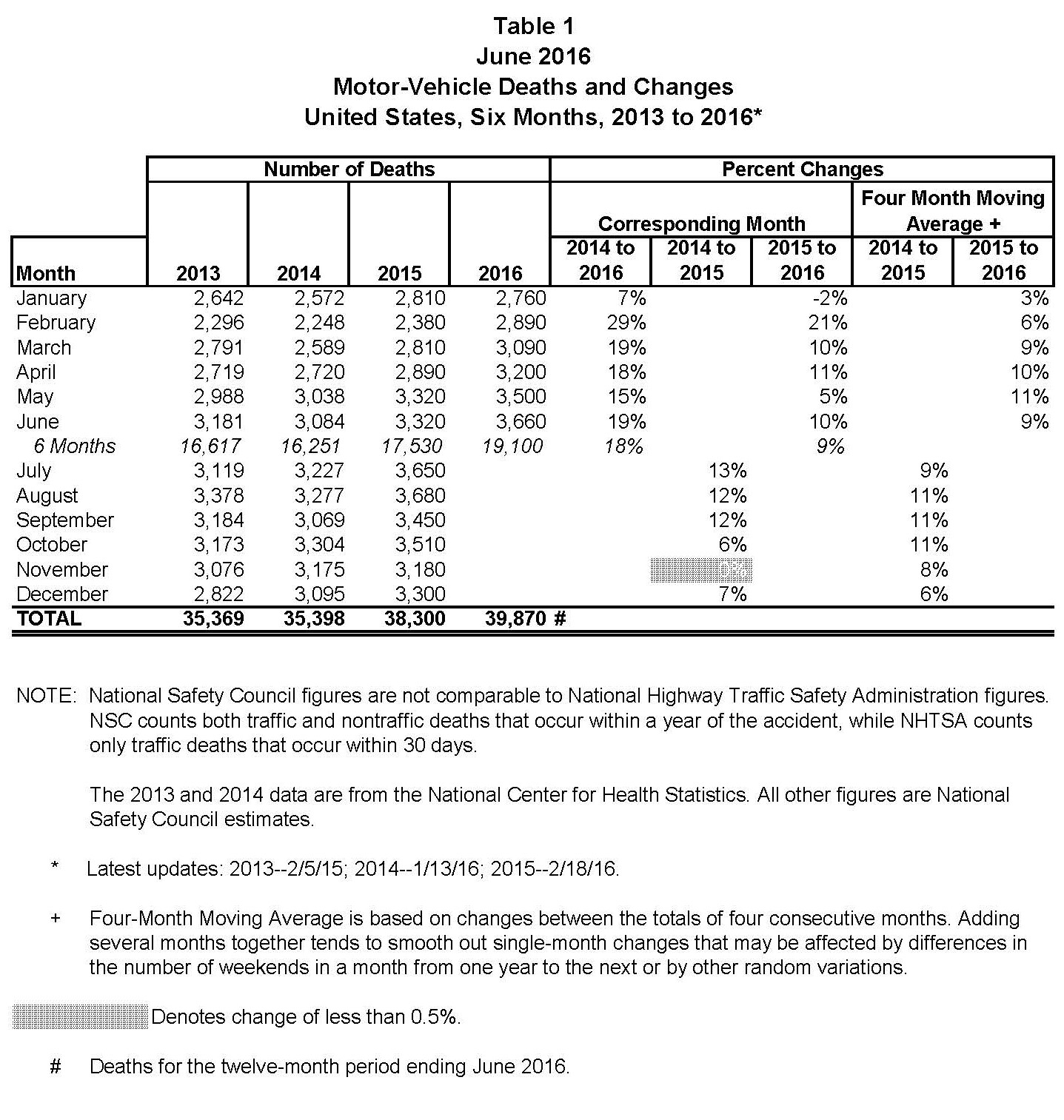Motor Vehicle Fatalities Up 9%; No Sign of a Decrease in 2016, says National Safety Council
Tuesday, August 23, 2016-Itasca, IL – Preliminary estimates from the National Safety Council indicate motor vehicle deaths were 9% higher through the first six months of 2016 than in 2015, and 18% higher than two years ago at the six month mark. An estimated 19,100 people have been killed on U.S. roads since January, and 2.2 million were seriously injured [i]. The total estimated cost of these deaths and injuries is $205 billion.
The upward trend began in late 2014 and shows no signs of decreasing. Last winter, the National Safety Council issued its largest year-over-year percentage increase in 50 years, when it estimated fatalities had jumped 8% in 2015 compared to 2014. The continued rise in fatalities is prompting the Council to issue its highest fatality estimate for the Labor Dayholiday period since 2008. NSC estimates 438 people will be killed during the three-day holiday weekend.[ii]
States that have been particularly hard hit since 2014, the start of the upward trend, are Florida (43% increase), Georgia (34%), Indiana (33%), California (31%), North Carolina (26%), Illinois (24%) and Kentucky (24%).
“Our complacency is killing us,” said Deborah A.P. Hersman, president and CEO of the National Safety Council. “One hundred deaths every day should outrage us. Americans should demand change to prioritize safety actions and protect ourselves from one of the leading causes of preventable death.”
While many factors likely contributed to the fatality increase, a stronger economy and lower unemployment rates are at the core of the trend. Average gas prices for the first six months of this year were 16 percent lower than 2015 levels, helping to fuel a 3.3% increase in the number of miles driven.
To help ensure safety, the National Safety Council recommends drivers:
- Make sure every passenger buckles up on every trip
- Designate an alcohol and drug-free driver or arrange alternate transportation
- Get plenty of sleep and take regular breaks to avoid fatigue
- Never use a cell phone behind the wheel, even hands-free
- Stay engaged in teens’ driving habits, as teens are three times as likely to crash as more experienced drivers
- Learn about your vehicle’s safety systems and how to use them.
My Car Does What ( mycardoeswhat.org ) can help drivers understand features such as adaptive cruise control, blind spot warning systems and backup cameras.
Motor vehicle fatality estimates are subject to slight increases or decreases as data mature.
[i] The National Safety Council defines “serious injuries” as those requiring medical attention
[ii] The Labor Day holiday weekend begins at 6 p.m. Friday, Sept. 2 and ends at 11:59 p.m. Monday, Sept. 5.
NSC Motor Vehicle Fatality Estimates
Motor-vehicle deaths continue to increase in first six months of 2016. Motor-vehicle deaths for January through June of 2016 totaled 19,100. This figure is up 9% from the corresponding period in 2015. The January through June figure for 2016 was up 18% from the 2014 figure. The 6-month total for 2015 was 17,530, an 8% increase from 2014. The 2014 figure was 2% lower than 2013. The estimated annual population death rate is 12.9 deaths per 100,000 population, an 8% increase from the preliminary 2015 rate of 11.9.
The estimated annual mileage death rate is 1.3 deaths per 100 million vehicle miles traveled, an increase of 8% from the preliminary 2015 rate of 1.2. If the level of increase in fatalities observed during the first two quarters were to remain through the end of the year, total motor vehicle fatalities in 2016 could possibly exceed 40,000 for the first time in nine years. The increase in fatalities in 2016 likely reflects the effects of the low real gas prices that have averaged over 16% below 2015 levels for first six months of 2016, helping to produce a 3.3% increase in cumulative vehicle mileage through May. It should be noted that gas prices and the economy are strongly connected and it is difficult to isolate the impact of lower gas prices from the overall impact of an improving economy.
Medically consulted motor-vehicle injuries for the first six months of 2016 are estimated to be about 2,196,000. As a result of a refinement made last year to the medically consulted injury estimate, comparison of medically consulted injuries to previous years is not appropriate.
The estimated cost of motor-vehicle deaths, injuries, and property damage through June was $205.5 billion. Due to recent updates to the Council’s cost model, comparison of current year cost estimates to previous years is not appropriate.


NSC has issued traffic fatality estimates since 1921.
